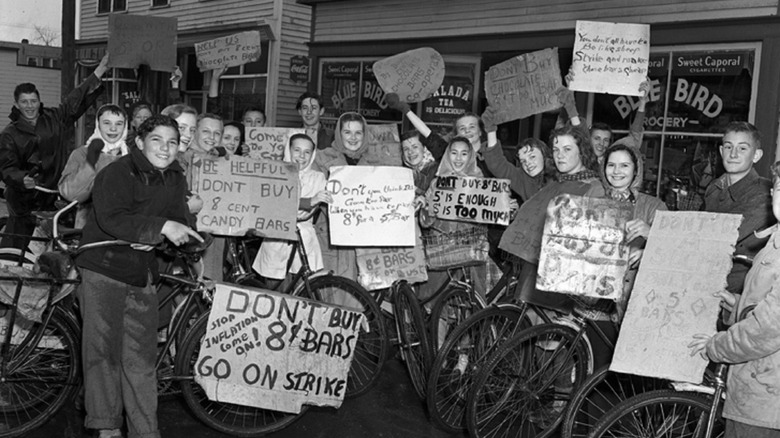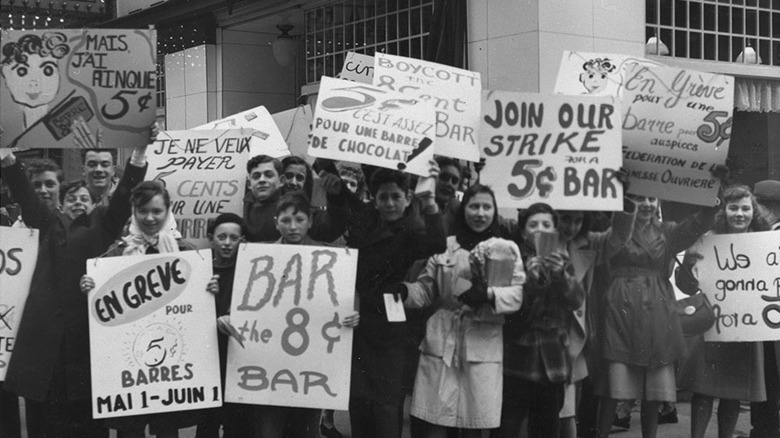How The Post-War Price Of Candy Bars Sparked A Children's Protest In 1947 Canada
Just like other nations, Canada's economy was affected by World War II. There was a price hike on goods, and as a result, several of the country's cities saw groups of people protesting. The public demonstration was unusual, however, as it consisted of children holding signs that revolted against the 3-cent increase in the price of candy bars. As reported by The Vintage News, Canada's chocolate manufacturers increased the price of chocolate bars from 5 cents to 8 cents overnight — a 60% boost. The manufacturers said that the price change was connected to the price rise for the ingredients used in making chocolate bars, such as milk, sugar, and cocoa beans. Additionally, it became more difficult to acquire cocoa beans from Africa.
On April 25, 1947, a group of children in Ladysmith, British Columbia, headed to a confectionary store where they typically purchased candy bars only to discover that the price had increased overnight. According to the Canadian Encyclopedia, children in Ladysmith were the first ones to stage a protest against the price increase of candy bars. The youth wrote signs and paraded on the streets in hopes their voices would be heard by the manufacturers.
The protests spread to other locations
The children's protest made it to the papers. They were photographed holding signs, and soon after, children in other locations followed. They went to the stores they frequented, holding signs and protesting the expensive chocolate bars, as Mental Floss reported. Kids in other cities protested as well in the days following the price increase. Children in Montreal, Quebec, Toronto, Calgary, Winnipeg, and Ottawa staged their own demonstrations in front of confectioneries. Some were escorted by adults who supported the cause, as noted by The Vintage News.
On April 29, 1947, about 300 kids in Edmonton began a strike against buying 8-cent chocolate bars. That same day in Victoria, 200 children protested at the provincial legislature, and 500 teens staged a demonstration at a park in Toronto, as reported by The Canadian Encyclopedia. Some even continued their protest under the pouring rain, as reported in an article in the North Bay Nugget on May 3, 1947, where one of the signs read, "We'll eat worms before we eat eight-cent chocolate bars." Pledge cards were passed around, and about 3,000 people signed to boycott the purchase of chocolate bars until they were back to 5 cents. Per The Canadian Encyclopedia, chocolate bar sales plummeted as much as 80% during the protests.
What happened after the boycott?
The youth's unrest about the price of chocolate bars prompted major chocolate manufacturers to explain the price hike. Willards' Chocolate Limited posted an advertisement titled "5 cents Chocolate Bars just aren't possible NOW!" and the company said that it, too, was not happy with the prices. Still, it had to be done because of taxes, labor, and the prices of ingredients (via Torontoist).
In May 1947, the Toronto Telegram published an article that stated that the protests were backed by communists in order to use the children for their own agenda, as noted by The Canadian Encyclopedia. The claim came from an anonymous source, and there was no concrete evidence to support the allegation. However, that was enough to put an end to the candy bar protests. One of the protesters, Parker Williams, stated that the demonstrations were done spontaneously and were organized by the children themselves. Williams was 17 years old in 1947 when a few children convinced him to write slogans on his car to help with the protest, as he told The Globe and Mail in 2012. After the protests died down, manufacturers agreed to decrease the price of a candy bar to 7 cents.


